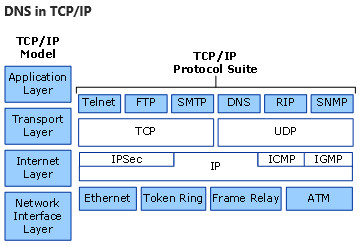Co je DNS (Domain Name System)?
DNS je standardní protokol, který poskytuje služby mapováníto-IP adres a mapování adres na počítače a uživatele. DNS je výchozí služba překladu ip adres používaná v sítích s Windows. DNS je součástí souboru protokolů TCP/IP a všechna síťová připojení TCP/IP jsou ve výchozím nastavení nakonfigurovaná s IP adresou alespoň jednoho serveru DNS, aby bylo možné provádět překlad názvů na síti.
Použití DNS ve Windows a Windows Serveru
Ve Windows Serveru je DNS role serveru, kterou můžete nainstalovat pomocí Správce serveru nebo příkazů Windows PowerShellu. Pokud instalujete novou doménovou strukturu a doménu Active Directory, DNS se automaticky nainstaluje současně s Active Directory jako server globálního katalogu pro doménovou strukturu a doménu.
Dns systému Windows Server se obvykle nasazuje v rámci podpory služby Active Directory Domain Services (AD DS). Služba Active Directory Domain Services (AD DS) používá DNS jako mechanismus umístění řadiče domény. Při provádění některé z hlavních operací služby Active Directory, jako je ověřování, aktualizace nebo vyhledávání, počítače k vyhledání řadičů domény služby Active Directory používají DNS. Řadiče domény navíc používají DNS k vzájemnému vyhledání.
Dns Windows Serveru se také běžně nasazuje bez služby Active Directory jako standardního řešení DNS. Jedním z příkladů tohoto použití je použití DNS Windows Serveru k hostování veřejných vyhledávacích zón organizace.
Klientská služba DNS je součástí všech klientských a serverových verzí operačního systému Windows a ve výchozím nastavení běží při instalaci operačního systému. Když nakonfigurujete síťové připojení TCP/IP s IP adresou serveru DNS, klient DNS kontaktuje server DNS za účelem zjištění řadičů domény a překladu názvů počítačů na IP adresy. Když se například síťový uživatel s uživatelským účtem služby Active Directory přihlásí k doméně služby Active Directory, služba Klienta DNS se dotazuje serveru DNS, aby vyhlašil řadič domény pro doménu služby Active Directory. Když server DNS odpoví na dotaz a poskytne klientovi IP adresu řadiče domény, klient kontaktuje řadič domény a proces ověřování může začít.
Server DNS systému Windows Server a klientské služby DNS používají protokol DNS, který je součástí sady protokolů TCP/IP. DNS je součástí aplikační vrstvy referenčního modelu TCP/IP, jak je znázorněno na následujícím obrázku.

Začněte
Začínáme s DNS ve Windows Serveru pomocí rychlého startu : Instalace a konfigurace serveru DNS na Windows Serveru.